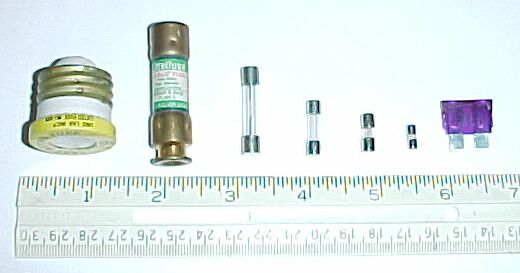Fuses





Fuses are used to cut of the current when it becomes too high, to protect the circuit. A fuse is usually just a piece of wire, that when the current reaches a certain point, the wire will melt, and the fuse will then need to be replaced. Fast acting fuses blow out from surges and extended high currents, while slo-blo do not blow out from sugrges, only extented high currents, and normal fuses are somewhere in between.

Some fuses are shown above. Most of the fuses have a way of seeing if the fuse has blown or not. In the first to the left, there is a window for looking at the wire. Other ones, such as those in the middle, are made of a glass tube that the wire runs right through. In the one on the far right, the wire can be between the two blades in the plastic.
NOTE: NEVER INSERT A FUSE INTO A DEVICE WITH A HIGHER RATING THAN THE DEVICE DESIGNED FOR. DOING SO CAN CAUSE DAMAGE TO THE DEVICE, AND WILL CAUSE AN INCREASED RISK OF A FIRE.
Water Analogy
A fuse is like a tube that is made from thin plastic, so that if the current is too high it will break the tube (blow the fuse). The problem with this analogy is that it is more likely the pressure in the tube will blow it, while in a fuse it is the current that blows it. And when the fuse is blown in the water circuit the water just spills out on to the ground, and electrons on the other hand don't tend to do that.
Related Topics: Circuit Breakers
Back to component chart
Back to search by schematic





